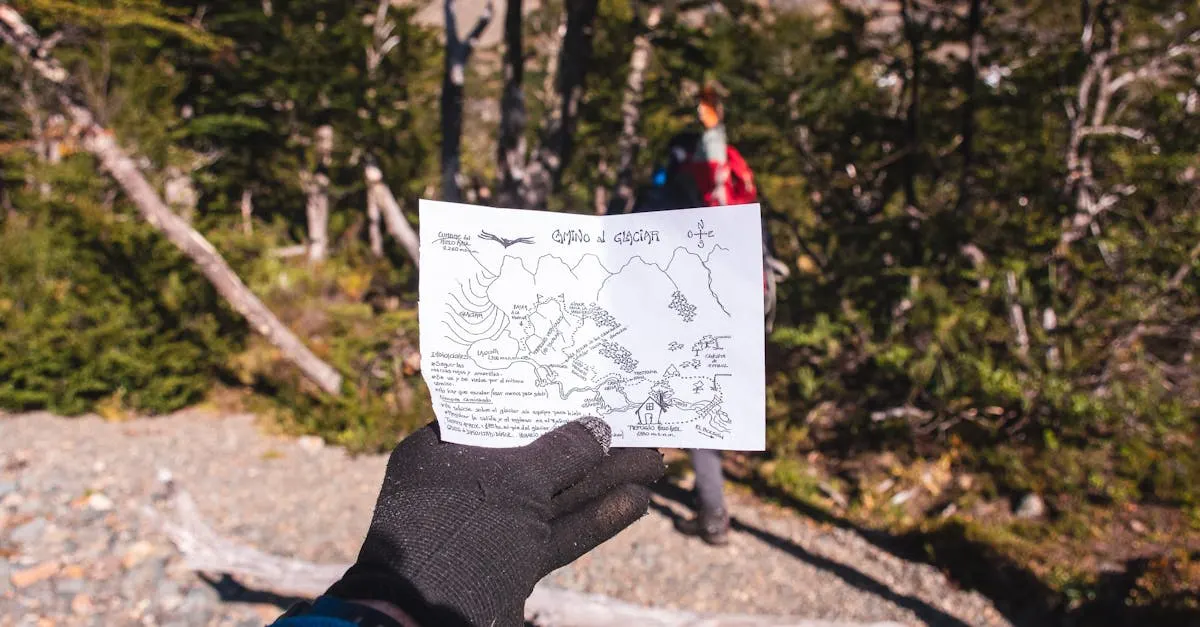Ever wondered what’s so special about the Oklahoma map? Well, you’re about to find out. Located in the South Central region of the U.S., Oklahoma’s unique geographical features make it a fascinating study.
Oklahoma‘s map showcases an intriguing blend of both western and eastern landscapes. You’ll notice the Great Plains, mountain ranges, and forests, all within the same state boundaries.
But, it’s not just about geography. The map also tells a story of the state’s rich history and cultural diversity.
So, buckle up as we take a deep dive into the Oklahoma map, exploring its various facets and what they reveal about this captivating state.
Geographical Features of Oklahoma Map
As you navigate through the Oklahoma map, you’ll appreciate the diversity found within its borders.
Stretching over the state’s 69,899 square miles, features like the Great Plains, forests, and mountain ranges rise to meet you.
The Great Plains are the most prevalent feature on Oklahoma’s map.
Dominantly occupying the state’s west, they showcase vast expanses of grassland. When exploring this area on a map, you’ll spot a complex patchwork of farmland, cattle ranches, and oil fields.
In contrast, the Ouachita Mountains are an eastern treasure.
Seeping into southeastern Oklahoma, they contain one of the oldest mountain ranges in the world.
Here, the pattern of landscapes changes dramatically. Transitioning from the plains, you’ll find a montage of ridges, valleys, and bodies of water embroidered into the land.
Then there’s the Cross Timbers, the peripheral belt dividing eastern deciduous forests from the Great Plains.
On the map, you’ll notice this region stretching from the southeastern edge, curving up towards the north like a ribbon. It’s a crucial ecological frontier with its mixture of prairie and woodlands.
You’ll also find the state‘s largest freshwater lake, Lake Texoma, straddling its southern boundary with Texas, a highlight for lovers of fishing and sailing alike.
Comparing the geographical feature diversity Oklahoma offers, let’s look at the numbers for a clearer image:
| Geographical Feature | Square Miles Covered |
|---|---|
| Great Plains | 33,000 |
| Cross Timbers | 4,100 |
| Ouachita Mountains | 1,500 |
| Lake Texoma | 89 |
So next time you glance at an Oklahoma map, remember that it’s more than just lines and colors.
It’s a testament to nature’s diversity, a painter’s palette sprawling with compelling hues of landscapes.
No matter where you’re headed, understanding the geographical features on the map can add more depth to your exploration of Oklahoma.

Western Landscapes on the Oklahoma Map
Unfolding westward, the Great Plains dominate the bulk of Oklahoma’s topography.
You’ll recognize this region with its wide-open vistas, sprawling farms, and ranches that stretch as far as the eye can see.
The Western Oklahoma map is a testament to the state’s agricultural prowess, with almost 80% of the state’s land being used for farming.
Oklahoma isn’t solely plains and grasslands though. Gypsum Hills, near the border of Kansas, surprise you with unexpected rugged landscapes.
The layers of red and white sedimentary rock, sculpted over eons into rounded hills and deep canyons, strike a stark contrast against the surrounding plains.
In the far west, the Black Mesa area signifies Oklahoma’s highest point.
Reaching an elevation of 4,973 feet, it’s largely untouched and offers scenes of raw, austere beauty. The Black Mesa Nature Preserve protects some of the area’s most tempting sights.
From unique desert wildlife to dark skies perfect for stargazing, it’s a Western Oklahoma gem.
The diversity of Western Oklahoma’s landscapes creates an interesting blend of ecosystems.
This area thrives in wildlife species native to prairies, mountains, and deserts. Hence, birdwatchers, naturalists, and wildlife enthusiasts find it an incredible playground.
Ultimately, viewing these features on the Oklahoma map, you’ll see how the land use varies incredibly across the state.
Whether it’s the expansive agrarian use in the Great Plains or the natural preserves in Black Mesa, Oklahoma shows how it’s much more than a single homogenous region.
| Landscape | Elevation / Size | Dominant Land Use |
|---|---|---|
| Great Plains | ~500 – 2000 feet | Agriculture (80%) |
| Gypsum Hills | ~1500 feet | Natural preserves |
| Black Mesa | 4973 feet | Natural preserves |
Eastern Landscapes on the Oklahoma Map
After marveling at the majestic western landscapes in Oklahoma, your journey continues to the eastern side of this diverse state.
Eastern Oklahoma boasts a completely different terrain, bursting with hardwood forests, hills, and lakes making the region as scenic as it is remarkable.
Ozark Mountains, often referred to as the Ozark Plateau is one prominent feature in eastern Oklahoma.
The majority of the Ozarks stretches into Missouri and Arkansas, but Oklahoma’s portion shouldn’t be undervalued.
Think of lush, green rolling landscapes studded with oak and hickory trees painting a breathtaking picture in your mind.
The illusion of being in a dense forest while just being part of a landscape spanning multiple states is a unique experience in itself.
Moving southeast, you’ll come across the Ouachita Mountains, a wild habitat that’s been beautifully preserved.
Unlike typical row-like mountain ridges, the Ouachitas have a distinct, east-west orientation making them a directional anomaly.
Southeastern Oklahoma, particularly the Ouachita Mountains, is incredibly biodiverse and is known for preserving unusual species of plants and animals such as the Ouachita Mountain shiner and the Ouachita crevice salamander.
Lastly, don’t miss out on the Arkansas River that flows through eastern Oklahoma.
It’s the sixth-longest river in the US and serves a critical role in transportation, providing a navigable waterway for a significant portion of the state.
Today, its riverbanks are thriving ecosystems and prime spots for fishing and recreation.
So when you’re looking at the map of Oklahoma, remember, it’s not just a place.
It’s an experience. Just as the Great Plains dominate the west, eastern landscapes such as the Ozark and Ouachita Mountains, and the Arkansas River contribute significantly to the state’s natural richness.
They perfectly echo Oklahoma’s geological saga and biodiversity.
Historical Insights from the Oklahoma Map
As you admire the natural beauty showcased on the Oklahoma map, it’s impossible to ignore the historical significance embedded within these landscapes.
Each mountain range, river, and forest tells a rich narrative of Oklahoma’s past.
For instance, the Ouachita Mountains played a crucial role in the state’s history.
Serving as a boundary between Native American nations, the Ouachitas were widely used for hunting and trading activities.
The Ozark Mountains too, tell tales of early settlers who explored, settled in, and ultimately shaped Eastern Oklahoma.
You’ll be fascinated to discover that the Arkansas River was a vital transportation route for Native American tribes and later, for trade and settlement during the westward expansion in the 19th century.

Today, these historical roots are evident in the numerous cultural heritage sites and festivals celebrated along the river’s length.
Also, are you aware that the vast forests of Eastern Oklahoma were once the economic lifeline of countless communities? The lumber industry thrived here, deeply influencing the region’s development.
So, as you explore the Oklahoma map, remember it’s more than just a geographical representation.
It’s a portrait of historical milestones that mark significant events, cultures, and economic transitions throughout the state’s history.
Let this realization make your journey through Oklahoma’s diverse landscapes even more meaningful.
Delving deeper into individual localities will reveal more local stories and nuances in Oklahoma’s history.
Whether it’s exploring old trade routes or immersing oneself in indigenous cultures, each corner of this state has a unique tale to tell.
The interaction of history and geography in Oklahoma offers a fascinating study of how the past has shaped its present.
Cultural Diversity Reflected on the Oklahoma Map
Beyond its geographical importance, the map of Oklahoma reflects a colorful blend of cultures.
As you trace the outlines of the Sooner State, you’re tapping into an incredible crossroads of cultural diversity.
This diversity, distinctly demarcated on the Oklahoma map, is the result of centuries of migrations, adaptations, and interactions.
Eastern Oklahoma, characterized by dense forests and rugged mountains, has been primarily the home to Native American tribes.
Areas like the Choctaw Nation and the Cherokee Nation, visible on the state map, have preserved their unique traditions, languages, and cultures.
As you move across the map, you’ll feel the essence of their cultural richness embedded in the lands.
The Central Plains tell a different story. Areas like Oklahoma City and Norman, marked prominently on the Oklahoma map, are buzzing urban centers.
They host diverse populations from all around the globe.
These locations are melting pots, where different cultures have intertwined and evolved, giving rise to an exciting cosmopolitan vibe.
Moving further west onto the Great Plains of the Oklahoma panhandle, yet another layer of cultural diversity unfolds.
The map of this region highlights areas like Guymon and Beaver County, which have a strong Hispanic influence.
The Oklahoma map, therefore, acts as a treasure map, leading to pockets of rich cultural legacies spread throughout the state.
It plays a unique role in capturing the cultural diversity of Oklahoma, laying it bare for any curious eye to explore.
The state’s past and present cultural landscapes are intricately woven together in the tapestry of its geography.
It’s this blending of geography and cultural history that makes studying the Oklahoma map a truly fascinating journey.
Frequently Asked Questions
What cultures have shaped Oklahoma?
Several cultures have shaped Oklahoma over the years. Eastern Oklahoma is home to Native American tribes like the Choctaw and Cherokee while central regions such as Oklahoma City and Norman represent global cultural diversity.
The Great Plains region, including places like Guymon and Beaver County, exhibits a strong Hispanic influence.
How does geography intertwine with cultural history in Oklahoma?
Geography and cultural history in Oklahoma are intricately tied together.
Each region showcases a different blend of cultural influences. As one traverses from east to the west, there is a palpable change from native cultures to more global and Hispanic influences.
What cultural influences are seen in Eastern Oklahoma?
Eastern Oklahoma showcases prominent Native American cultural influences. It is home to tribes like the Choctaw and Cherokee nations, whose unique traditions continue to be preserved.
What cultural diversity is seen in urban centers of Oklahoma?
Urban centers like Oklahoma City and Norman, found in Central Plains, show a strong blend of diverse global cultures. They serve as melting pots where cultures from around the world intersect and mingle.
Are there any Hispanic influences in Oklahoma?
Yes, there are strong Hispanic influences seen in western Oklahoma, particularly in areas like Guymon and Beaver County in the Great Plains region.

Conclusion
- You’ve journeyed across the Oklahoma map, discovering a tapestry of cultures that have shaped the state’s rich history.
- From the Native American heritage deeply rooted in Eastern Oklahoma to the cosmopolitan vibe of cities like Oklahoma City and Norman, you’ve seen how cultural diversity thrives in this land.
- Venturing westward, you’ve encountered the Hispanic influence that permeates the Great Plains.
- This exploration of the Oklahoma map isn’t just about geography – it’s an immersive experience of the cultural legacies that make Oklahoma a unique and vibrant state.
- So next time you look at an Oklahoma map, remember it’s not just lines and boundaries – it’s a story of cultures intertwining across centuries.

